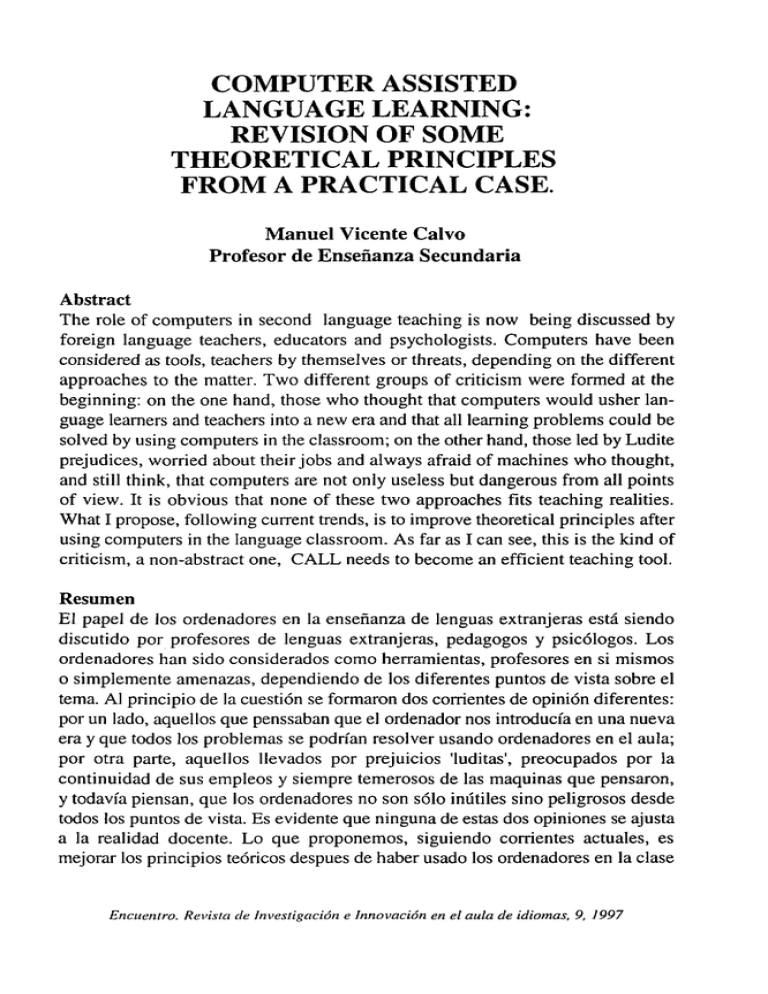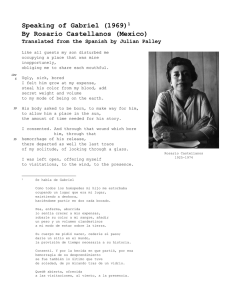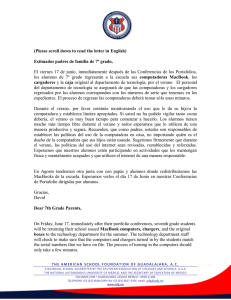Computer Assisted Language Learning. Revision of
Anuncio

COMPUTER ASSISTED LANGUAGE LEARNING: REVISIÓN OF SOME THEORETICAL PRINCIPLES FROM A PRACTICAL CASE. Manuel Vicente Calvo Profesor de Enseñanza Secundaria Abstract The role of computers in second language teaching is now being discussed by foreign language teachers, educators and psychologists. Computers have been considered as tools, teachers by themselves or threats, depending on the different approaches to the matter. Two different groups of criticism were formed at the beginning: on the one hand, those who thought that computers would usher language leamers and teachers into a new era and that all leaming problems could be solved by using computers in the classroom; on the other hand, those led by Ludite prejudices, worried about their jobs and always afraid of machines who thought, and still think, that computers are not only useless but dangerous from all points of view. It is obvious that none of these two approaches fits teaching realities. What I propose, foUowing current trends, is to improve theoretical principies after using computers in the language classroom. As far as I can see, this is the kind of criticism, a non-abstract one, CALL needs to become an efficient teaching tool. Resumen El papel de los ordenadores en la enseñanza de lenguas extranjeras está siendo discutido por profesores de lenguas extranjeras, pedagogos y psicólogos. Los ordenadores han sido considerados como herramientas, profesores en si mismos o simplemente amenazas, dependiendo de los diferentes puntos de vista sobre el tema. Al principio de la cuestión se formaron dos corrientes de opinión diferentes: por un lado, aquellos que penssaban que el ordenador nos introducía en una nueva era y que todos los problemas se podrían resolver usando ordenadores en el aula; por otra parte, aquellos llevados por prejuicios 'luditas', preocupados por la continuidad de sus empleos y siempre temerosos de las maquinas que pensaron, y todavía piensan, que los ordenadores no son sólo inútiles sino peligrosos desde todos los puntos de vista. Es evidente que ninguna de estas dos opiniones se ajusta a la realidad docente. Lo que proponemos, siguiendo corrientes actuales, es mejorar los principios teóricos después de haber usado los ordenadores en la clase Encuentro. Revista de Investigación e Innovación en el aula de idiomas, 9, 1997 de inglés. En nuestra opinión éste es el tipo de crítica, no abstracta, que CALL necesita para convertirse en una herramienta de eneseñanza eficiente. 1. INTRODUCTION CALL (Computer Assisted Language Learning) started in the 70s in the U.S.A.; since then computers have changed a lot, becoming easily handable machines that can be found almost everywhere: shops, TV, or schools. At school, the introduction to the use of is now an important subject, but it is more than a subject. The M.E.C. (Spanish Educational Authorities) encourages the use of computers with programs like Atenea that include courses for teachers and provide them with suitable software to develop part of their job with an important help. But sometimes all this help becomes useless due to misuse, lack of interest or simply because the software or hardware used is not really suitable. These failures can be used to revise theoretical principies that will improve practice afterwards. This is the main idea of my experience that I will try to reflect in this article. 2. DESCRIPTION OF THE GROUP After taking some courses on CALL and doing some reading on the subject in the winter of 1992-93, I decided to make an attempt to apply CALL in the I.F.P. "Molina". This was a small vocational school with very special features that can be seen in the following lines. "Nuestros alumnos son de procedencia rural, (...) de Moüna y (...) la comarca: (...) zona de despoblamiento creciente y muy aislada (...) A este aislamiento hay que añadir la pobreza de recursos y la escasa oferta cultural: no hay librerías, ni cine (...) La oferta de ocio es mínima (...) el empleo del tiempo libre de nuestros alumnos se limita a las frecuentes visitas a bares y pubs (...) Estas características del entorno repercuten en nuestros alumnos, quienes acuden al centro con escaso dominio del lenguaje oral y escrito: presentan deficiencias de lectura, comprensión, redacción, vocabulario, ortografía, caligrafía (...) Estas deficiencias se acentúan notablemente si consideramos las lenguas extranjeras. El aislamiento de la zona se agrava debido a la escasez de canales de TV, no se captan programas internacionales, la antena parabólica del CEP está mal orientada y apenas se sintonizan emisoras de radio (...) el turismo es mayoritariamente interior, (...) por consiguiente los alumnos no tienen la posibilidad de 128 entrar en contacto con nativos y poner en práctica los idiomas. No hay prensa local'", The computer room of the school had eight 386 Olivetti computers^ that were going to be used by groups of nine to sixteen students; this meant that work was not strictly individual for some groups and, of course, this had some influence on the resuJts obtained. The ages of students working with the computers were between fourteen and seventeen belonging to the first and second year of vocational training. Two of the groups were training to become car mechanics and the other two for being secretaries. The results were at least encouraging, but that is not not the main point. The point is to check whether theoretical advantages and disadvantages are real in the fíeld, and if not, try to make suggestions to help CALL to advance and become a useful teaching tool. 3. CRITIQUE OF SOME OF THE ADVANTAGES OF CALL As I said above my critique of the advantages of CALL comes from my practical application; of course, my point of view might be considered very narrow but I still think it useful for possible experiences. These advantages I will discuss are now considered almost universal and can be found in all the manuals on the subject; specially clear and easy to read is Computers in EngUsh Language Teaching and Research by Leech and Candlin, but most of the ideas expressed in this book are now accepted as "universal truths" in CALL. Anyway, they must be criticized to be fully developed. Environment of the gioup as it is described by teachers in the Curricular Project of I.E.S. Molina, first prepared in 1993. 2 The programs used were Learning with Fun and My English Partner; both of them are availabie at any school or CEP. The first one emphasizes on the learning of new vocabulary, while the second one is perhaps more complete. 129 Computers can cope with the real needs of individuáis^. It is true that computers allow students to set their own personal pace of work, because they are very "patient" and flexible tools. The problem comes when the relationship teacherstudent acquires a new element: the computen The attention paid to students, specially those with problems related to the language taught, diminishes due to new problems created by that new element because the mental models of students cannot be transferred to a machine and teachers have to cope with this too. Typing mistakes, a bad treatment of errors with loud beeps or the fact that computers cannot cope with the unexpected are new possibilities that must be taken into account and that make individuáis even more teacher-dependent. This is not the only possible criticism; another is that the Spanish educational system does not allow students to work with a computer on his/her own. Computers have to be shared by, at least, two students. This way individual needs cannot be catered for. They increase motivation, maínly in non self-motivated students'. This point could be checked in the first session of each group, but motivation decreased along the foliowing sessions when the computer ceased being a new element and started to be considered as another teaching tool by students, specially by those who were less interested in English or computers. I think motivation depends on the interests of individual students ratherthan on the use of computers. Computers are more and more familiar everyday even for young students and contribute to "hreak the walls between the classroom and the outside world"^ because they are widely used everywhere and they are not specific teaching tools like language labs or blackboards. However this advantage is a risky one. The teaching-learning process must be a meaningful one; contents and methods must be as real as possible, but "the breaking of the walls" can turn teachers into a redundant element. This maybe the reason why some teachers have been frightened by computers and even thought their jobs threatened by a tireless, extremely patient and cheaper teacher: the computer. But in a student-centred environment familiarity is, of course, an advantage. Those fears and prejudices that Phillips, Martin "CALL in its educational context" in Leech and Candlin (ed), 1984, Computers in English Language Teaching and Research. Windeatt, Scott "Observing CALL in action" in Leech and Candlin's Computers in... ^ Cfr. n. 3. 130 some teachers feel towards machines are not felt by our young students, even if they do not know a single word about computers. If students worlc in pairs, as it is the case, computers favour interaction and the new role of the teacher is to encourage intragroup and intergroup interaction. Most authors think that computers do not favour it but as far as I could see my students^ tried to help each other with the computer or language problems. The differences between my experience and Windeatt's is probably due to the fact that my students worked in pairs which is the usual situation in computer rooms in Spanish schools and due to the differences between Windeatt's students and mine: his were university students highly motivated and with a clear and individual idea of what they wanted to achieve from the computer; on the other hand, mine were not self-motivated students and did not have a clear aim. So the experience was a kind of experiment for them more than a lesson. There is one opinión that both groups of students shared: they had doubts about whether they would leam anything useful from the computer. But this will be discussed later on. There is an improveinent ofsecurif/. This point depends upon the programme used for the experience. As I said above, if the computer beeps when students make a mistake, they may feel threatened by it. But what is worse is that the computer, a machine, cannot make any distinction between errors. A typing mistake receives the same treatment as a grammar or lexical mistake. Interchanging two letters that are really cióse in the keyboard (B-M) can give us words that have nothing to do with each other: bother-mother. This keyboard frustration can be even worse if the software we use misleads us; that is to say, if the instructions are not clear and easy to understand or the programs are not user-friendly ones. Most of the software available does not allow students to develop all their skills because it is too restrictive and unimaginative. It is almost useless for younger leamers that must be guided to oral language as it is acknowledged by most foreing language ^ Cfr n. 4. Alderson, J. Charles "Computers in language testing" in Leech and Candlin's Computersin... 131 teachers, including those developing CALLl But let's give up criticizing and give some possible solutions acquired from reading and practica. 4. WHAT TO DO TO USE CALL? SOME PIECES OF ADVICE The only way to avoid all these points is to go on researching and making critical approaches to CALL and this can only be made through practica. One of the points stated before , the faulty programs, is just a consequence of the gap that existed, and still exists, between teachers, linguists and programmers. There are two ways of filling in this gap: al! teachers should learn how to program a computer, quite unlikely and difficult, as there is no proportion between effort, time and progress; the other way is the use of Authoring packages that allow teachers to introduce new texts and exercises with little effort. This appropiate "new" software must have the following characteristics: -It must have self-access facility, -It must contain learner-centred activities in a student-centred setting, -It must have clear and not too long instructions, as Higgins' proposes mixing screen and paper can be very useful,and so it is to use our voice to make clear what we want our students to get from the computer. It is clear to see that if we want to consider computers as partial substitutes for teachers the software we use must always and primarily consider leamers' initiatives and teachers' programático. What is left for teachers, then? The fírst task for teachers, when they are planning to use CALL in their classes, is to think about what is taught and what is learnt. When the explicit classical teaching is insufficient, the CALT programs can be a good help. But we have to think what we want to do and then, see if we cannot do it without a computer. If the computer is the only way of solving a teaching problem then we have to prepare our lesson very carefuUy; if not, computers have proved themselves quite Thomas, Jenny "Adapting dBaselI: the use of datábase management systems in English language teaching and research" in Leech and Candlin's Computers in... ú Higgins, John "Reading, writting and pointing: communicating with the computer" in Leech and Candlin's Computers in.. 132 effective for self-leaming but not so effective in a classical teaching environment. This point of view can be stated in most of the articles on the matter and in practica! examples like mine. Let's consider now what we have to do once we have decided we are going to use the computen We have to choose the right program to fit our students' needs, our computers (number of them, model), and our curriculum. The role of the teacher must be separated from the role of the cornputer. Teachers must pay more attention to pre and post-task analysis, diagnosis of errors and communication. Teachers should observe their students' reaction to the use of computers and the records of their performances. If possible, we should compare the progress made with computers and traditional methods. Another important part of the teacher's role is to be the tuming point of an interintra group negotiation. This means provoking, along with the cornputer, interaction in the group and between different groups or students. Since the use of computers is very demanding for both teacher and students we must make the most ofit. Teachers, at least in Spain, must take care of the organizational and maintenance problems and make sure that the suppossed flexibility of computers is a real one. It is necessary to check hardware and software very often. And last but not least, teachers must start a continuous training in the appropiate way, that should be eminently a practical one. We don't have to leam how to program a computer,it is not necessary at all. We just have to leam how to make a presentation of a CALL session, to choose the right activity and control the class to make sure the planned progress is achieved. But before making any attempt and if you want it to be successful, please make sure about: -what you have (students,computers), what you want (goals of your lesson); and after having used it ask yourself about -what you have obtained and if it was worth. Plan everything very carefully; otherwise you might think that computers are useless. And overa)), let other teachers know about your experience; this is the only way to improve CALL from a practical point of view. 133 BIBLIOGRAPHY Chesters, G. and Gardner, N. (Ed.) 1987. The Use of Computers in the Teaching of Language and Languages. Bath. Jung, U. (Ed.) 1988. Computers in Applied Linguistics and Language Teaching. A CALL Handbook. Kenning, M. J. and Kenning M. 1983. An Introduction to computer Assisted LanguageLearning. OxfordUniversity Press, Oxford. Leech, G. and Camdlin, Ch. N. (Ed.) 1986. Computers in English Language Teaching and Research. Longman, London and New York. Ruipérez, G. 1990. Introducción a la enseñanza de lenguas asistida por ordenador. Madrid: UNED. 134





